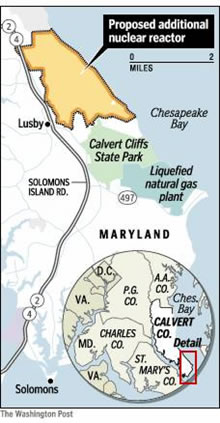
 CCAN opposes the construction of a third nuclear reactor at Calvert Cliffs.
CCAN opposes the construction of a third nuclear reactor at Calvert Cliffs.
There, I sa id it.
id it.
The secret is out. CCAN, a climate group, also opposes the development of new nuclear power. We’ve joined up with the Chesapeake Safe Energy Coalition to fight this new Maryland reactor.
Why is this? Isn’t nuclear power going to be part of the climate solution? How are we going to shut down all the dirty, carbon-emitting coal plants and have enough electricity to power our laptops and tvs and i-pods and microwaves without nuclear energy?
Here are some answers for you. First of all, nuclear power is going to be a part of the climate solution – existing reactors that are already pumping energy into our grid shouldn’t be shut down as a matter of course. However, investment in new nuclear power as a climate solution is disingenuous, at best.
One commonly-touted claim is that nuclear power is carbon-neutral:
While electricity generated from nuclear reactors does not directly emit global warming pollution, the nuclear fuel chain does produce greenhouse gases. As the world demand for nuclear energy and uranium rises, the quality of uranium that will be available will decline, and require more energy intensive (and more costly) processing. Eventually, global warming pollution from nuclear energy may be higher than that from natural gas plants. (click here for full factsheet)
In addition, investing in energy efficiency is a far more cost-effective way of dealing with both global warming pollution and energy shortages. Other, cleaner forms of energy, such as solar and wind, can compete economically with nuclear power, and cause considerably less environmental degradation.
This brings me to my next point. Cost.
Calvert County already has granted $300 million in tax breaks to Constellation Energy. This is equal to $4,500 per taxpayer in Calvert County. The new plant will add 450 full-time jobs in thecounty, but at a cost to taxpayers of approximately $750,000 per job. Constellation will seek additional subsidies from the federal government and may seek additional financing from the state.Constellation could also potentially seek to have some of the cost of the new plant paid for by electricity ratepayers, by adding the cost of the plant to the rate base that customers pay. (click here for full factsheet and sources)
With all of this tax money getting poured into a nuclear reactor, especially during a budget crisis, do you really think that there will be money left over for the state to invest significantly in renewable energy like home solar tax incentives or offshore wind farms? Yeah, I don’t either.
If you’re starting to get fired up, there are plenty of ways to get involved. The MD Public Service Commission will be holding a series of public hearings in August, so stay tuned for opportunities to submit your comments. Not only that, but I’ll be continuing to post updates on this fight throughout the summer – including more information on this particular plant, resources for you to learn more, and ways to connect with other activists.
PS – If you’re interested in learning more about other worrisome aspects of nuclear power (like terrorism possibilities and waste disposal), CSEC has a some more really informative factsheets. Woo, factsheets



 This week I’m going to be in Wise County, where Dominion Power is planning to build a $1.8 billion coal-fired power plant. Members of the Sierra Club, Appalachian Voices, Southern Appalachian Mountain Stewards and CCAN are putting on events around the meeting of the Air Board on Tuesday.
This week I’m going to be in Wise County, where Dominion Power is planning to build a $1.8 billion coal-fired power plant. Members of the Sierra Club, Appalachian Voices, Southern Appalachian Mountain Stewards and CCAN are putting on events around the meeting of the Air Board on Tuesday.
 This week I’m going to be in Wise County, where Dominion Power is planning to build a $1.8 billion coal-fired power plant. Members of the Sierra Club, Appalachian Voices, Southern Appalachian Mountain Stewards and CCAN are putting on events around the meeting of the Air Board on Tuesday.
This week I’m going to be in Wise County, where Dominion Power is planning to build a $1.8 billion coal-fired power plant. Members of the Sierra Club, Appalachian Voices, Southern Appalachian Mountain Stewards and CCAN are putting on events around the meeting of the Air Board on Tuesday.
 This week I’m going to be in Wise County, where Dominion Power is planning to build a $1.8 billion coal-fired power plant. Members of the Sierra Club, Appalachian Voices, Southern Appalachian Mountain Stewards and CCAN are putting on events around the meeting of the Air Board on Tuesday.
This week I’m going to be in Wise County, where Dominion Power is planning to build a $1.8 billion coal-fired power plant. Members of the Sierra Club, Appalachian Voices, Southern Appalachian Mountain Stewards and CCAN are putting on events around the meeting of the Air Board on Tuesday.